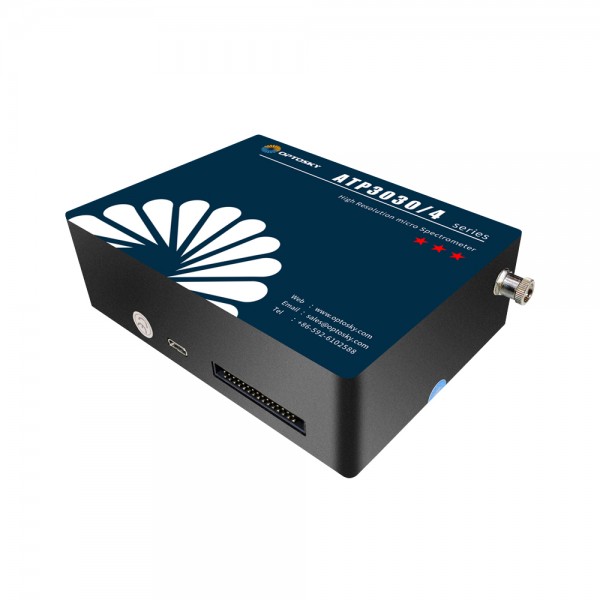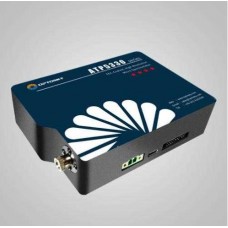- ATP3034 is UV-enhanced designed with extra high resolution in the region of UV region. ATP 3034 designed M-shape optical bench with super resolution and stray light with a resolution of 4096 pixels.
- ATP3034 is a ultra-high resolution micro spectrometer developed by Optosky. The highest resolution can reach 0.05nm, which is suitable for all kinds of high-resolution applications. At the same time, it has the characteristics of high reliability, ultra-high speed, low cost, high cost performance and so on. It can be used in various environmental applications such as online testing.
- ATP3034 is perfect for fast detection attribute to its high A/D converter frequency and the high speed data transmission. In ATP3034 memory chip, some algorithms to improve the performance are programed solidly, such as wavelength calibration coefficients, linearity coefficients. ATP3030 operates with a single +5V DC supply supplied from USB or UART.
- ATP3034 has free SDK for customers self-developed, Optosky support C++, C#, Labview and Linux system SDK, which is very convenient for OEM customers to design solutions.
| Detector | |
| Detector type | Linear array detector |
| Effective pixels | 4096pixels |
| Pixels dimension | 7 µmX200 µm |
| Detector model | Hamamatsu S13496 |
| Sensitivity | 1300(lx.s) |
| Dark noise | 13 RMS 13° |
| Optical parameter | |
| Optical resolution | 0.05-2 nm(decide on slit and spectral range) |
| Incident Interface | SMA905 connector |
| Signal-to-noise | >600:1 |
| Dynamic range | 8.5×10^7(system); 2000:1 for a single acquisition |
| confocal distance | 75mm |
| Numberical aperture | 0.06 |
| Working humidity | < 90%RH |
| Trigger | YES/IN and OUT |
| Cooling temperature | uncooled |
| Full Well | NA |
| Scanning rate | < 1 kfps |
| Wavelength range | 350-800nm, 200-400nm, 200-850nm, 200-945nm, 600-1000nm, 800-1000nm(available in custom wavelength) |
| Slit Size | 50 µm( 25,100 µm are optional) |
| SNR | >1000:1 |
| Optical Design | M-type |
| Physical parameters | |
| Dimensions | 124×90×37.5mm^3 |
| Weight | 0.55kg |
| Sealing | Anti-sweat |
| Electrical parameter | |
| Integration time | 0.1 ms - 256 s |
| Supply voltage | DC 4.5 to 5.5V ( type@ 5 V) |
| Operating current | 170mA@Typ. |
| Storage temperature | <0.05% at 600nm; <0.09% at 435nm |
| Operating temperature | -25°c to + 50°c |
- High resolution, low stray light
- Max range: 180-1150nm
- Resolution: 0.05-2nm
- Light path: M-shape
- Detector: 4096 pixel CMOS
- Integration time: 0.1ms - 60s
- Power: DC 5V±10% or USB power
- ADC: 16 bit
- Sample rate: 2 MHz
- Output: USB 2.0 or UART
- USB connector: USB Type-C;
- Plasma luminescence detection;
- LIBS
- Raman spectrum detection;
- Wavelength monitoring, laser, led, etc
- Water quality analyzer
- Ultraviolet flue gas analyzer
- Led sorter and color detection;
- Micro and fast spectrophotometer;
- Spectrum analysis, radiation spectrophotometry and spectrophotometry
How to select High resolution & uncooled spectrometer from Optosky?
ATP3030 (2048pixels) & ATP3034 (4096pixels) both uses M-shape C-T, higher resolution, low stray light, uv enhanced application is highly recommended.
Optosky ATP3XXX series are high resolution and uncooled spectrometer.
ATP3000 (2048pixels) & ATP3040 (4096pixels) both uses crossed C-T, higher sensitivity, they are usually used to replace HR2000 and HR4000
ATP3330 (2048pixels) & ATP3334 (2048pixels) ) both uses M-shape C-T, higher resolution, low stray light, NIR range can also applicable to high resolution.
How many topology structure of optical path for a spectrometer?
There are commonly divided into 4 types of optical path, including crossed C-T, M-shape C-T, concave grating optical path, transmittance grating opitcal path.
Crossed C-T: ATP2000P,ATP2002, ATP2400, ATP1010, ATP5020P, ATP5040, ATP6500
M-shape C-T: ATP3030, ATP3034, ATP3330/4 ATP5030, ATP5034, ATP5330/4
Concave grating: ATP4230, ATP4020, ATP4050, ATP4070
let's see the M-shape optical path looks like a number "3", so our models uses the 3rd number "3" to indicate M-shape optical path models.
In generally, topology structure can decide resolution, sensitivity, stray light, and size of a spectrometer.
Crossed C-T topology structure employs better sensitivity and compact size.
M-shape C-T employs higher resolution and better stray light.
Concave grating optical path employs high stray light.











